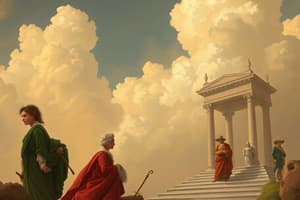Podcast
Questions and Answers
What were the three major cultural developments in the 18th century in Europe and America?
What were the three major cultural developments in the 18th century in Europe and America?
- Romanticism
- Neoclassicism (correct)
- The Enlightenment (correct)
- Rococo style (correct)
What did Enlightenment thinking emphasize?
What did Enlightenment thinking emphasize?
Scientific empiricism and the doctrine of progress
What is the meaning of 'Ancien Regime'?
What is the meaning of 'Ancien Regime'?
An old order under which everyone in France belonged to one of three classes
What does 'femme savante' refer to?
What does 'femme savante' refer to?
What type of painting is 'fete galante'?
What type of painting is 'fete galante'?
What characterizes grand manner portraiture?
What characterizes grand manner portraiture?
Who are the 'philosophes'?
Who are the 'philosophes'?
What does Rococo refer to?
What does Rococo refer to?
What philosophical belief is associated with Rousseau?
What philosophical belief is associated with Rousseau?
What is Neoclassicism?
What is Neoclassicism?
What is 'exemplum virtutis'?
What is 'exemplum virtutis'?
Who is associated with the Rococo painting 'The Swing'?
Who is associated with the Rococo painting 'The Swing'?
What notable work is John Singleton Copley known for?
What notable work is John Singleton Copley known for?
What is Jacques-Louis David known for?
What is Jacques-Louis David known for?
What building did Thomas Jefferson design in the Neoclassical style?
What building did Thomas Jefferson design in the Neoclassical style?
Flashcards are hidden until you start studying
Study Notes
Cultural Developments in the 18th Century
- The 18th century in Europe and America saw the rise of Rococo style, the Enlightenment, and Neoclassicism, reflecting significant socio-political changes.
- Rococo style emphasized elegance and intimacy, contrasting with the grand palace culture of the previous century.
- Antoine Watteau, a leading Rococo painter, used light colors and delicate lines to portray French high society.
Enlightenment and its Impact
- The Enlightenment featured critical thinking, scientific empiricism, and the doctrine of progress, influencing the French and American Revolutions.
- Humanism drove individuals to undertake Grand Tours of Italy, rediscovering Classical Antiquity and Renaissance art.
- Excavations at Herculaneum and Pompeii contributed to a renewed interest in classical art and culture.
Neoclassicism
- Neoclassicism arose as a movement reviving classical forms and themes in art and architecture.
- Jacques-Louis David emerged as the prominent French Neoclassical painter, illustrating themes of virtue and heroism.
- Richard Boyle's Chiswick House in England is a notable example of Neoclassical architecture inspired by Ancient Rome.
- Thomas Jefferson, influenced by Neoclassicism, designed Monticello and the University of Virginia, reflecting civic ideals of the American republic.
Key Terms and Concepts
- Ancien Régime: The old social order in France, categorized into three classes.
- Femme Savante: Refers to cultured female salon hosts during the Rococo period.
- Fête Galante: A Rococo painting genre that portrays outdoor amusements of the upper class.
- Grand Manner Portraiture: An 18th-century portrait style emphasizing elegance through composition elements like scale and pose.
- Philosophe: Social thinkers in France during the Enlightenment advocating for reason and reform.
- Rococo: An ornate style of art and architecture characterized by elaboration, prevalent in 18th-century France.
- Rousseau: Philosopher who advocated for the notion of the "natural man," free from societal constraints.
- Exemplum Virtutis: Art that conveys moral messages intended to guide the viewer.
Notable Artists and Works
- Jean-Honoré Fragonard: Known for the painting "The Swing," exemplifying Rococo style.
- John Singleton Copley: Famous for "Paul Revere," which reflects the naturalistic approach of the 18th-century art movement.
- Jacques-Louis David: Renowned for "Death of Marat," a quintessential work of Neoclassicism.
- Thomas Jefferson: Architect of Monticello, symbolizing Neoclassical architecture in early American identity.
Studying That Suits You
Use AI to generate personalized quizzes and flashcards to suit your learning preferences.




